Mastering Room Partitions: A Comprehensive Guide
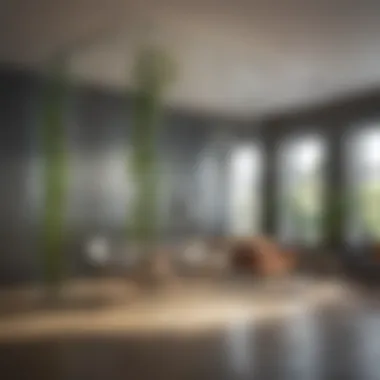
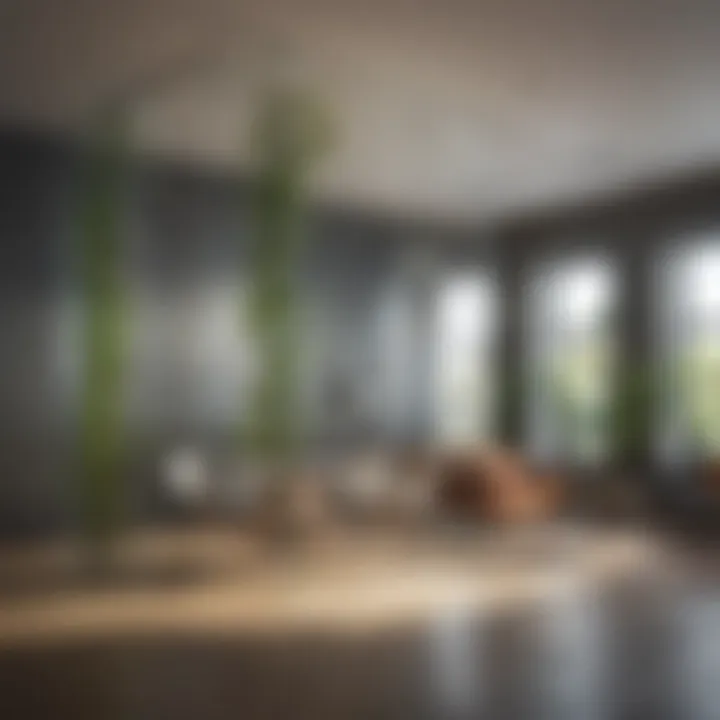
Intro
Room partitions have become increasingly important in modern interior design, as we seek to maximize space in our homes. They offer flexibility, functionality, and aesthetics, making it easier to define areas within an open layout. Understanding how to effectively create room partitions can transform how we interact with our living environments. In this guide, we will explore various types of partitions, practical steps to implement them, and design considerations that can enhance the overall look of your space.
Key Insights and Trends
Current Trends in Interior Design
In today’s design landscape, minimalism remains a significant trend. Many homeowners opt for sleek and unobtrusive partitions that contribute to an airy atmosphere. Folding screens, glass dividers, and modular units are becoming popular choices. These allow for versatile configurations while maintaining an open feel. Additionally, the use of natural materials, such as wood and stone, is on the rise. These choices can add warmth and texture, providing a natural connection to the outside environment.
Types of Partitions
The choice of material and type of partition should align with the intended function of the space. Here are some common types:
- Folding Screens: Easy to move and perfect for temporary divisions.
- Bookshelves: Serve dual purposes for storage and division.
- Curtains or Fabrics: Offer a soft, flexible option that can be opened or closed.
- Glass Panels: Create a modern look while allowing light to flow through.
Practical Tips and How-To Guides
Step-by-Step Guide for Implementation
To create an effective room partition, follow these steps:
- Define the Purpose: Consider what you need the partition for. Is it for privacy, organization, or aesthetic purposes?
- Choose Your Materials: Based on the function, select appropriate materials that match your home’s decor.
- Measure Your Space: Accurate measurements ensure a good fit and functionality of the partition.
- Plan the Layout: Visualize how the partition will fit into your room and how it will interact with existing furniture.
- Installation: Follow through with installation instructions specific to your chosen partition type. For built-ins, professional assistance may be needed.
"Effective room partitions can significantly enhance both the functionality and aesthetic quality of a living space."
Maintenance Tips
To maintain your partitions, consider these tips:
- Regularly dust and clean surfaces to keep them looking fresh.
- Check for structural integrity, especially for movable pieces.
- Refresh the look by changing out artwork or fabric coverings if applicable.
In summary, creating an effective room partition requires thoughtful consideration of design, materials, and purpose. By understanding the current trends and practical methods, homeowners can improve functionality and style in their living spaces.
Understanding Room Partitions
Room partitions are essential elements in interior design. They serve not only to divide spaces but also to enhance the functionality and aesthetics of a room. Recognizing what room partitions are, as well as their purpose, benefits, and various types, is crucial for anyone looking to create efficient living environments.
This article delves into the principles of room partitions, focusing on their role in optimizing space and improving privacy. As homeowners or design enthusiasts, understanding these factors enables informed decision-making regarding room layout and design. Consequently, effective room partitions can transform any space, making it more versatile and visually appealing.
Definition and Purpose
A room partition is any structure that divides a space into smaller areas. It can be permanent or temporary and may vary in design, material, and functionality. Partitions can be built from walls, screens, or even furniture, acting as barriers that offer separation without completely closing off spaces.
The purpose of room partitions goes beyond mere separation. They redefine how a room is used, allowing for multi-functional areas. For instance, in an open-plan living room, a partition can delineate a home office while maintaining an airy, spacious atmosphere. Those living in homes with limited square footage especially benefit from such flexibility, as each section can cater to different activities or needs.
Benefits of Using Room Partitions
Using room partitions offers several advantages. They not only help in managing space better but also contribute to privacy and aesthetic improvements. Let us examine these benefits more closely:
Space Optimization
Space optimization refers to making the best use of available area. One of the key aspects of space optimization is that it allows for different functions to exist in a single environment. Adding a partition creates distinct areas for activities, whether for relaxation, work, or play.
This adaptability makes partitions a popular choice in modern homes, especially those with open layouts. By utilizing partitions, homeowners can create zones that serve varied purposes, increasing a room's overall utility. However, care must be taken to ensure that partitions do not overcrowd the space, which can lead to a cramped feeling.
Acoustic Privacy
Acoustic privacy is another important factor in room design. This refers to reducing noise pollution between spaces, offering a tranquil atmosphere within a home. Partitions, depending on their material and design, can absorb sound more effectively than simple furniture arrangements.
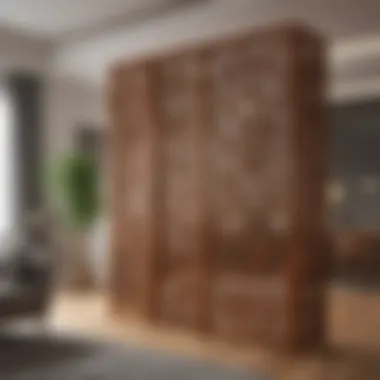
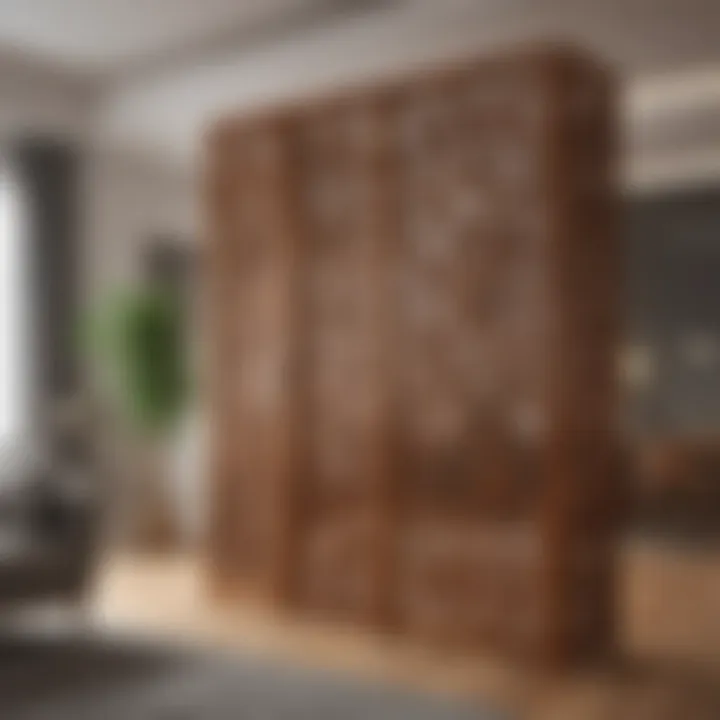
The key characteristic of acoustic partitions is their ability to isolate sound. This benefit is particularly valuable for those who work from home or have family members with varying schedules. While not all partitions are equally effective at sound dampening, using thicker materials can enhance this feature significantly, though they might limit the visual aspects of open spaces.
Aesthetic Enhancement
Aesthetic enhancement is about improving the visual appeal of a room. Partition walls, screens, or creative furniture can add character and style. Choosing a design that aligns with the overall decor can elevate the room, making it more inviting and appealing.
The unique feature of aesthetic partitions is that they can serve as artwork or design elements while simultaneously dividing spaces. This dual functionality is advantageous for those looking to add personality to their homes without sacrificing utility. However, it is crucial to ensure that these enhancements do not clash with the existing style, as harmony is vital in interior design.
In summary, understanding room partitions is fundamental for anyone looking to optimize their space systematically. This knowledge equips homeowners, designers, and enthusiasts with the tools to transform any area into a well-organized and pleasant environment.
By evaluating definitions, purposes, and benefits such as space optimization, acoustic privacy, and aesthetic enhancement, one can appreciate the total value of effective room partitions.
Types of Room Partitions
Understanding the various types of room partitions is crucial in creating effective spatial solutions. Each type offers distinct benefits and considerations to cater to different needs and preferences. The choice between temporary and permanent partitions can shape the functionality of a space.
Temporary vs. Permanent Partitions
Temporary partitions are favored for their flexibility. They can be moved or removed depending on changing needs. This makes them ideal for renters or those who frequently rearrange their space. They allow for quick adjustments without committing to a permanent change.
In contrast, permanent partitions provide a stable and enduring solution. These are generally more robust and often require professional installation. They can enhance structural integrity and can be a focal point in interior design. However, they lack the flexibility that temporary options offer.
Material Choices for Room Partitions
Selecting the right material is fundamental to maximizing the effectiveness of a room partition. Different materials bring various characteristics, influencing both functionality and aesthetics.
Wood
Wood is a popular choice for partitions due to its warmth and versatility. It can be crafted into traditional styles or modern designs. Its natural appearance can add a touch of elegance to a room. However, wood may require maintenance over time, such as polishing or sealing to prevent wear. It is also susceptible to moisture, which can lead to warping. In spaces with high humidity, alternative materials might be more suitable.
Glass
Glass partitions create an airy and open feel. They allow natural light to flow between spaces while maintaining some degree of separation. This material is frequently used in contemporary designs. Glass partitions can be either frosted for privacy or clear for an open effect. However, one drawback is their fragility; glass must be handled with care. Proper framing and installation are essential to avoid accidents.
Fabric
Fabric partitions offer a softer appearance compared to other materials. They can be easily changed to match seasonal trends or personal tastes. They are lightweight and often used for temporary setups, such as at events or in multi-purpose spaces. On the downside, fabric may require regular cleaning to maintain appearance, and it is less durable than hard materials.
Metal
Metal partitions are celebrated for their industrial aesthetic and durability. They can withstand daily use and are often used in commercial settings. Additionally, metal can be combined with other materials for a unique look. However, they may create a more sterile environment, which might not be appealing in more homey settings. Noise can also reflect more off metal surfaces, which could lead to acoustic issues.
Creative Partition Ideas
Exploring creative partition ideas can provide innovative solutions tailored to personal preferences. Combining functionality with aesthetics is key to enhancing space.
Sliding Panels
Sliding panels offer a space-saving solution while providing flexibility. When not in use, they neatly tuck away, which minimizes clutter in the space. This type can easily blend with various decor styles, making it a versatile option. However, track systems for sliding mechanisms need accurate installation to ensure proper functionality.
Bookshelves
Bookshelves as partitions serve a dual purpose—they function as a storage solution and a divider. They can display books and decorative items. This can add character to a room. Additionally, bookshelves can provide some privacy without fully closing off spaces. The challenge lies in ensuring stability, especially when filled with heavy items.
Foldable Screens
Foldable screens are a practical way to create divisions in a space temporarily. They can be easily stored or rearranged as needed. Their decorative aspects can enhance room aesthetics. However, the material choice is vital, as some screens may not hold up well in heavily used areas.
Exploring various types of room partitions allows homeowners and designers to tailor spaces to unique needs and preferences. Each type offers specific functions and styles, making it essential to consider individual requirements.
Planning Your Partition
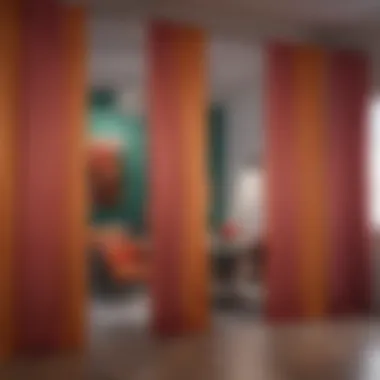
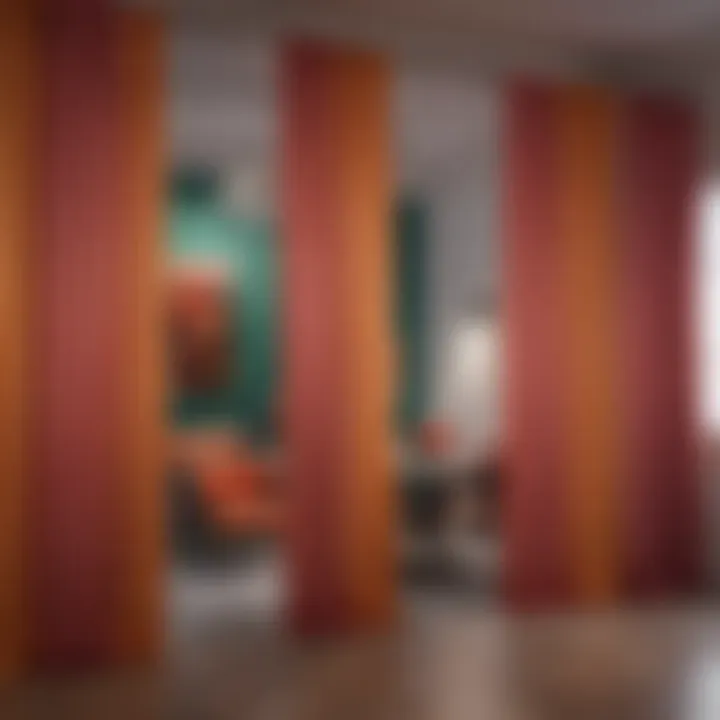
Planning your partition is a critical step in the process of optimizing space in any room. Room partitions allow homeowners and designers to redefine areas without the commitment of structural changes. When executed with clear intention, a partition can improve functionality and enhance the aesthetic appeal of your living space. This section provides key insights into how to understand your available space, the intended use, and how thoughtful design can lead to satisfying results.
Assessing Your Space
Size and Layout
Assessing the size and layout of a room is fundamental to the effectiveness of a room partition. A partition should align with the dimensions of your space rather than obstruct it. The layout refers to how the items and areas within the room are organized. A well-planned layout considers both movement and functionality. This aspect is particularly beneficial when deciding where to place furniture or how to segregate different areas, be it for relaxation, work, or gatherings.
A key characteristic of size and layout is ensuring that the partition complements existing structures and furnishings. For instance, a large, bulky partition in a small room can create confinement rather than separation. Alternatively, an open layout may benefit from a partition that subtly divides areas while maintaining a sense of spaciousness. The unique feature of size and layout is that it allows for personalization based on the homeowner's needs and preferences. However, an often seen disadvantage is failing to account for natural light and airflow, which can make areas feel closed off.
Establishing Purpose and Functionality
Understanding the purpose of the partition is crucial. Are you looking to create a private workspace, a cozy reading nook, or a dedicated area for entertainment? Each function requires a different type of partition. For example, a home office might benefit from a full-wall divider that offers sound dampening, while a temporary screen could work well for occasional guest quarters. Defining the functionality helps steer material choice and design approach, leading to a more effective implementation.
Design Considerations
Color Schemes
Color schemes play a significant role in how a partition can influence the overall feel of a room. The right colors can enhance the harmony of design while separating spaces effectively. Soft hues can create a sense of openness, while bold tones can add drama to a space. A popular choice is to blend the partition's color with existing walls or decor. This not only maintains continuity but allows the partition to serve its purpose without overwhelming the room.
A unique feature of considering color schemes is how it can transform the mood of a space. Brighter colors can signal energy and creativity, while muted tones are more calming. However, the challenge with color is that trends shift, and selecting a color that might not age well could detract from the investment made in the partition.
Style Coordination
Style coordination refers to the alignment of the partition with the existing decor and architecture of the home. It is crucial to ensure that any partition complements rather than clashes with the overall interior design. A modern partition may look out of place in a traditional setting, creating visual dissonance.
Key characteristic of style coordination is that it fosters a seamless transition between areas of the room. Whether minimalist, eclectic, or classic, selecting a style reinforces thematic unity throughout a space. A disadvantage might arise when overly stringent adherence to one style limits creativity. Balancing personal taste with cohesive design allows the homeowner to express individuality while maintaining space integrity.
The Implementation Process
The implementation process is crucial in creating an effective room partition. It consists of practical steps that turn your design concept into reality. This phase ensures that all plans are executed thoroughly, reflecting your purpose while maintaining functionality and aesthetics. When proper attention is given during this stage, the outcomes can elevate the atmosphere of your space substantially. Whether you aim for privacy, distinct zones, or decorative flair, the method of implementation can make or break the overall success of your project.
Gathering Necessary Tools and Materials
Tools Required
Gathering the right tools is an essential aspect of setting up your room partition. Be sure to have tools such as a hammer, level, drill, and measuring tape handy. These items are fundamental for accuracy and efficiency. A level helps ensure that your partition stands straight, contributing to a professional look.
One key characteristic of choosing the right tools is compatibility. Tools like cordless drills provide flexibility and ease of use, making them very popular among DIY enthusiasts. However, selecting the wrong tool can lead to frustrations and delays, so it's worth investing time in research.
Additionally, powering your tools with reliable energy sources maintains smooth workflow. Ensure that you use tools that match your planned materials to prevent injury or mishaps. There is a variety of options available when it comes to tools, but selecting the most appropriate can dramatically enhance your overall success in creating an attractive and functional room partition.
Material Sourcing
Material sourcing is another vital component of the implementation process. It involves selecting and acquiring the materials you will use for your partition. Common choices include wood, glass, metal, and fabric. Each material has its own unique properties, influencing both appearance and functionality of your partition.
Wood is a solid choice for durability; it can provide a sense of warmth. Glass partitions, on the other hand, create an open feeling without sacrificing privacy. The diversity of materials means you can choose options that best suit your style and requirements.
One major consideration with material sourcing is availability. It is essential to find materials that are easy to source to keep your project timeline on track. Advantages such as cost-effectiveness and sustainability can also play a key role. When you choose your materials wisely, you can achieve not only great aesthetic results but also practical benefits for your living space.
Step-by-Step Installation Guide
Preparing the Area
Preparing the area for your room partition is fundamental. This step involves clearing out necessary space and ensuring that the surface is ready to support the partition. Measuring the dimensions accurately is essential to avoid any issues later.
One key characteristic of this preparation is thoroughness. Taking time for this stage can save you from significant mistakes down the line. This makes it a beneficial practice in any kind of installation.
Unique features of proper preparation include checking for electrical outlets or plumbing that may be hidden behind walls. Be wary of these potential pitfalls, as they will influence how you position your partition. Investing effort during this stage can lead to a smoother installation process and ensure that your partition aligns well with your overall vision.
Assembly Instructions

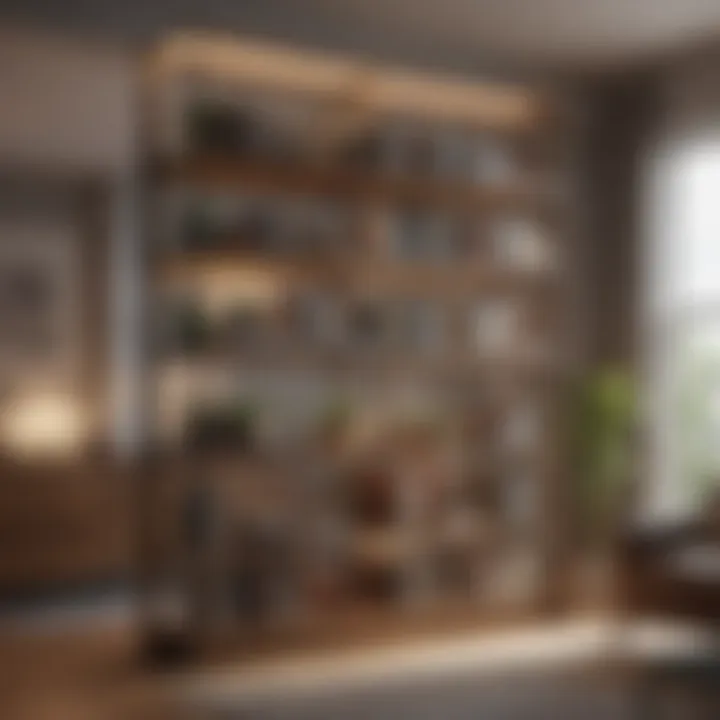
Assembly instructions guide you through the actual erection of the partition. Following detailed steps is necessary to maintain structure and stability. Each part must fit together properly to ensure functionality. This stage often includes aligning frames, securing anchors, and adjusting elements for a precise fit.
The key characteristic of effective assembly instructions is clarity. Clear and concise guidelines are vital for success. Improper execution during assembly can lead to collapsing structures or unsatisfactory results.
One unique advantage of having step-by-step instructions is that it allows even beginners to undertake the project without fear. Ensuring that your assembly process is systematic and well-planned will foster confidence in your ability to create an effective partition.
Finishing Touches
Finishing touches add the final layer of personality to your room partition. This can include painting or staining wood, installing decorative elements, or even adding lighting. Spending time on these details can upgrade the aesthetic appeal significantly.
A critical characteristic of this stage is attention to detail. Small changes can have a large impact on the overall look of your partition. Proper finishing touches can elevate your room from merely functional to a unique statement piece in your home.
One unique feature of completing these touches is the opportunity to personalize your space. It allows you to express your style while maintaining a practical function. Investing effort in this last step can leave a lasting impression on anyone who steps into your space, ensuring that your effort in creating the partition was well worth it.
Post-Installation Considerations
Once the partition has been installed, it is essential to focus on post-installation considerations. This phase can significantly impact how well the partition serves its purpose. Maintenance and evaluation are two primary components to ensure longevity and functionality of the partition.
Maintenance of Room Partitions
Maintaining room partitions involves consistent care to ensure they remain aesthetically pleasing and functionally effective.
Cleaning Techniques
Cleaning techniques for room partitions vary depending on the material. For example, glass partitions require glass cleaner and a microfiber cloth to prevent streaks. Wood partitions benefit from a soft cloth and occasional polishing. Regular cleaning prevents dust buildup and maintains the appearance of the partition.
One key characteristic of effective cleaning is the use of non-abrasive materials. This choice is beneficial, as it avoids damaging the surface of the partition, extending its lifespan. Additionally, a simple cleaning routine helps in avoiding long-term buildup that may require more intensive cleaning methods later.
Advantages of these techniques include ease and effectiveness in keeping partitions looking new. However, some materials, such as fabric, may require specialized cleaning products to avoid damage.
General Maintenance Tips
General maintenance tips are vital for ensuring that room partitions serve their purpose over time. Checking for stability and securely attaching any hardware is critical. Periodically inspect seams and edges for wear or damage.
A key characteristic involves regular maintenance checks. This also includes ensuring that any movable parts, like sliding panels, operate smoothly. Overall, these practices prevent costly repairs and provide peace of mind.
The unique feature of regular maintenance is the ability to catch problems before they become serious. While generally straightforward, neglecting basic maintenance may lead to more complex issues. This results in time-consuming repairs down the line.
Evaluating Effectiveness of the Partition
Evaluating the effectiveness of a room partition is a crucial step to determine if it meets its intended goals. Such evaluations help in making future improvements and adjustments.
Functionality Assessment
Functionality assessment focuses on whether the partition effectively creates the desired separation. Measurement is based on how well it impedes noise or how it contributes to privacy in a shared space. The key characteristic of this assessment lies in its practical application; it addresses real needs in daily life.
A thorough functionality assessment is a beneficial choice because it directly correlates to user satisfaction. Knowing whether the partition meets its intended purpose can guide decisions on adjustments or future purchases. Its unique feature is its hands-on nature, making it intuitive for homeowners to gauge.
However, it may also highlight deficiencies if the partition does not perform as intended, leading to adjustments that might not have been initially planned.
Aesthetic Appeal
Aesthetic appeal evaluates how well the partition integrates with the overall interior design. This aspect may also influence how spaces feel and function for everyday use. The key characteristic of aesthetic appeal is the emphasis on visual harmony with the surrounding environment.
Considering aesthetics is a popular choice because it directly affects personal satisfaction with a room. It enhances the living experience by aligning the partition’s design with the home’s overall style. A unique benefit of focusing on aesthetic appeal is its impact on mood and perception of space, adding to the emotional value of the environment.
There may be disadvantages, such as the risk of prioritizing appearance over practicality, which could lead to underperformance in function. Regular assessments of both functionality and aesthetic will ensure an effective balance for a room partition.
End
Creating an effective room partition is not solely about dividing a space; it is about intelligent design and functionality. Through careful consideration of layout, purpose, and materials, homeowners and design enthusiasts can enhance their living environments significantly. Room partitions enable better organization, promote privacy, and add an aesthetic element to spaces that might otherwise feel disjointed or overcrowded.
When considering the installation of a room partition, it is crucial to evaluate not just the immediate needs but also the long-term implications of such a decision. This article has covered various aspects, from understanding the types of partitions available to the implementation process, and the maintenance that follows. By grasping these concepts, individuals can make informed choices, ensuring that their partitions serve their intended purpose effectively.
Additionally, the benefits of room partitions extend beyond simple segregation of spaces. They promote space optimization, allowing for multifunctional areas that adapt to different uses. Furthermore, they can significantly contribute to acoustic privacy, ensuring that noisy activities in one area do not affect the serenity of another. Lastly, a well-designed partition can enhance the overall aesthetic appeal of a room, turning a functional divider into a stylish focal point.
In summary, room partitions are a powerful tool in interior design that facilitate better utilization of space, improve privacy, and elevate overall decor. They deserve careful consideration in any renovation or design project. Thus, the final takeaway is to approach room partitions not just as practical barriers, but as integral components that can enrich the living experience.



